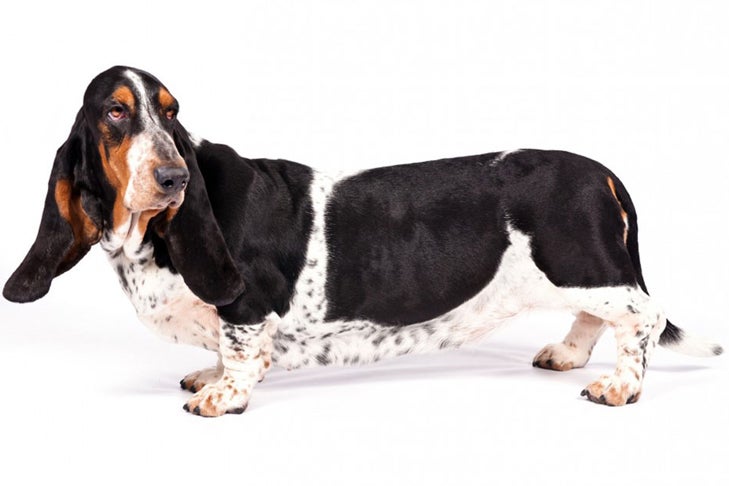
Under the “General Appearance” section, the official breed standard for the Basset Hound reads:
The Basset Hound possesses in marked degree those characteristics which equip it admirably to follow a trail over and through difficult terrain. It is a short-legged dog, heavier in bone, size considered, than any other breed of dog, and while its movement is deliberate, it is in no sense clumsy. In temperament it is mild, never sharp or timid. It is capable of great endurance in the field and is extreme in its devotion.
My favorite quote from Margaret (Peg) Walton’s 1993 book The New Basset Hound reads: “One must always remember the operative words here are size considered. Judges should not think that because of the wording ‘heavier in bone’ that the hound must have as much as a Saint Bernard.”
This phrase needs to be repeated early and often to everyone—breeders and judges. Yes, the Basset Hound has substance, more than any other 14- to 15-inch dog (over 15 inches is a disqualification for the breed, and 14 inches is preferred). In the Hound Group, that means only Beagles and PBGVs are about the same size as a Basset. Dachshunds should be smaller, and all other hounds are bigger. (Even the Basenji is bigger, since size is always defined as height at the withers.)
Now think about the bone size, or substance, of those breeds. It is unlikely that even the most refined Basset in the show ring today will be more refined than any of the PBGVs or Beagles in the ring.
Peg Walton emphasized size considered for a reason: She feared that too many people would simply breed for massive bone without relating it to the size of the dogs—a problem seen both in this country and in Europe.
Bassets lend themselves to becoming caricatures. If ears should “extend beyond the end of the nose,” does that mean two inches beyond is better than one inch? If the standard says “loose skin,” how many wrinkles does that take? Everyone knows the Basset is a dwarf breed—but how short is too short?
Evaluating correct or sufficient bone is one of the areas in which I see many mistakes made in judging the Basset Hound. When there are dogs in the ring ranging from moderate to massive, most judges naturally point to the massive dogs, in spite of other redeeming qualities that may be present in the moderate dogs. As an exhibitor, I know it is far easier to put points on massive, unsound dogs than it is to put points on correctly structured and more refined Bassets. I think this is wrong, and it sends the wrong message to breeders.
Form follows function. I want judges to understand that Basset Hounds were designed for endurance in the field, not as couch ornaments. This is a sound breed, and it must not have any characteristic so exaggerated as to inhibit its work in the field. The standard reads that the gait is smooth, powerful, and effortless. Movement is deliberate and in no sense clumsy. Yet I see judges point to big, overdone, clumsy dogs much more often than more refined, good-moving, soundly structured dogs without exaggeration. Judges sometimes confuse caricature with type.
Always remember that the serious faults mentioned in the Basset standard are in the running gear and head—not in profile, substance, or even tail carriage. I repeat that phrase in my mind every time I judge the breed. I understand the argument that pits soundness against “type.” However, good breed type is far different from caricature.
Soundness must never be sacrificed for extreme in bone. As Peg Walton said, they do not require the bone of a Saint Bernard! —Jacquelyn Fogel, Basset Hound Club of America, November 2012 AKC Gazette

